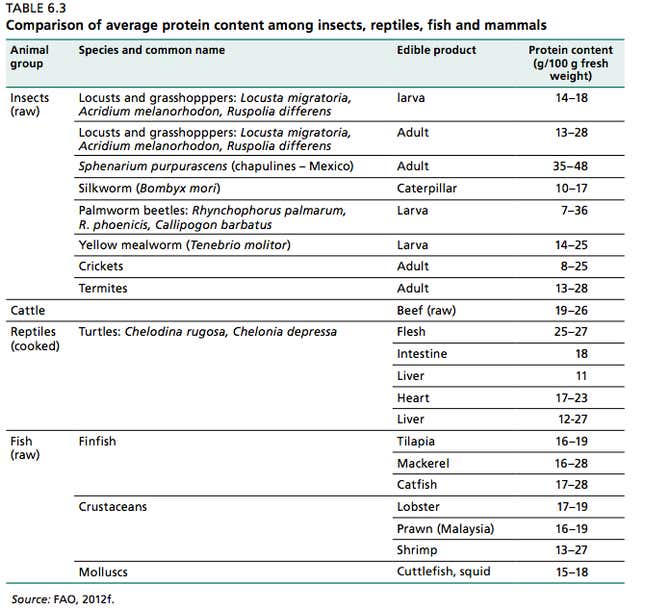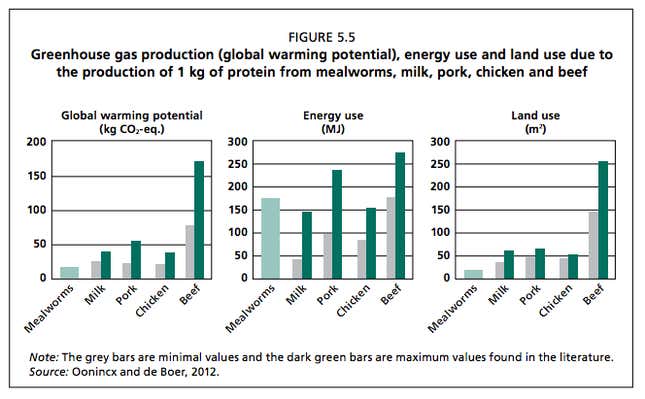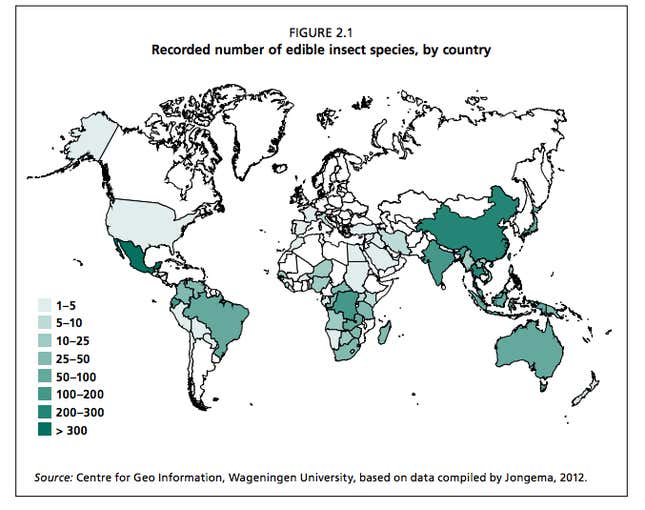In the West, insects are pests, a source of torment with whole industries devoted to their destruction. But they might be the key to the looming global food crisis. (The food supply has to double by 2050 to feed a projected population of 9 billion.)
Currently, 2 billion people eat insects around the world, primarily in Africa, Asia, and Latin America, where the practice has a thousand-year precedent, according to a new report by the Food and Agriculture Organization released today. Worldwide, beetles, caterpillars, bees, wasps and ants are the most widely consumed species.
Here are the basics on why so-called “mini livestock” is such an appetizing option for our health and the environment:
1. They provide necessary nutrients
The FAO report finds that adult locusts and grasshoppers have comparable levels of protein to raw beef (though the levels of protein, fat and fiber vary by species and preparation). In most insect-eating societies, mini livestock make up a sizable portion of the needed daily dose of protein, calcium, zinc and iron.

2. Insects release fewer greenhouse gases than traditional livestock
Rearing traditional livestock accounts for 18% of greenhouse gas emissions (pdf, p .63), which trumps emissions by the transportation industry. Both industries emit far more greenhouse gases than mealworm, cricket, and locust producers. Insects also release much less ammonia and methane than pigs and cattle.

Rearing insects uses less land and water than cattle-rearing. It’s also a way to make use of organic waste. The Netherlands has invested $1.3 million in finding ways to raise edible insects on food waste.
3. It makes economic sense
As global food prices have risen, the cost of animal feed has weighed down farmers and driven up meat prices. Because they are cold-blooded, insects require less energy to stay warm and are therefore more efficient at converting feed into protein (crickets, for example, need 12 times less feed than cattle, four times less than sheep, and half as much as pigs and broiler chickens to produce the same amount of protein). Also, the cost of gathering insects (as is the practice in developing countries) or producing them at scale is relatively low.

4. They are less likely to make us sick
Insects are taxonomically distant from humans, which makes them less likely to transmit diseases—a good thing in the era of food-borne maladies like H5N1 and mad-cow disease. Even so, mass producing any livestock comes with some risk of unknown diseases. The authors of the FAO report acknowledge the need for more research in determining potential health risks.
5. They’re everywhere
There are edible insects living in forests, farmland and water. While habitat destruction and climate change make the population uncertain, there are more than 1,900 edible insect species.

Humans, on average, already unintentionally ingest an estimated 1 pound of insects a year, mixed in with other foods. Insects are even popping up on Western high-end restaurant menus, which could take bug-eating mainstream. Says food writer Michael Pollan, “It would take a lot of work by our best chefs to shift this cultural norm. Any precedent? One I can think of: we’ve learned in the West to eat, and enjoy, raw fish. This will be even harder, but it’s not out of the question.” The trick to opening up Western palates? Find some better bug names.
Correction: A previous version of this piece referred to SARS as a foodborne illness. It is a zoonotic illness.
